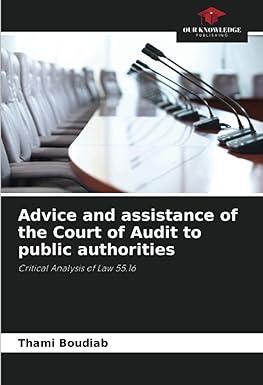Question
Ryder Company produces a single product, school backpacks made of a sturdy nylon fabric. The production of these bags requires a relatively large amount of
Ryder Company produces a single product, school backpacks made of a sturdy nylon fabric. The production of these bags requires a relatively large amount of labour time. Overhead cost is applied on the basis of standard direct labour-hours. The companys condensed flexible budget for manufacturing overhead is given below:
| Cost Formula | Direct Labour-Hours | |||||||||||
| (per DLH) | ||||||||||||
| Overhead Costs | 12,000 | 15,000 | 18,000 | |||||||||
| Variable manufacturing overhead cost | $1 | $ | 12,000 | $ | 15,000 | $ | 18,000 | |||||
| Fixed manufacturing overhead cost | 75,000 | 75,000 | 75,000 | |||||||||
| Total manufacturing overhead cost | $ | 87,000 | $ | 90,000 | $ | 93,000 | ||||||
Each backpack requires 2 metres of direct material that has a standard cost of $1.50 per metre. The product requires 1.5 hours of direct labour time. The standard labour rate is $10 per hour.
During the year, the company had planned to operate at a denominator activity level of 15,000 direct labour-hours and to produce 10,000 units of product. Actual activity and costs for the year were as follows:
| Number of units produced | 11,000 | ||
| Actual direct labour-hours worked | 17,500 | ||
| Actual variable manufacturing overhead cost incurred | $ | 15,750 | |
| Actual fixed manufacturing overhead cost incurred | $ | 76,500 | |
Required:
1. Compute the predetermined overhead rate for the year. Break the rate down into variable and fixed components.
| Predetermined overhead rate | per DLH | |
| Variable rate | $1 | per DLH |
| Fixed rate | per DLH | |
2. Do the following:
a. Compute the standard direct labour-hours allowed for the years production.
|
b. Complete the following manufacturing overhead T-account for the year:
Manufacturing Overhead
| Actual or applied? | Actual or applied? | ||
| Actual or applied? | Actual or applied? | ||
| over or underapplied? | over or underapplied? |
3. Determine the reason for the underapplied or overapplied overhead from requirement (2) above by computing the variable overhead spending and efficiency variances and the fixed overhead budget and volume variances. (Indicate the effect of each variance by selecting "F" for favorable, "U" for unfavorable, and "None" for no effect (i.e., zero variance).)
|
|
4. If the company had chosen 18,000 direct labour-hours as the denominator activity rather than 15,000 hours, indicate which of the following variance given below would change.
| |||||||||||
Step by Step Solution
There are 3 Steps involved in it
Step: 1

Get Instant Access to Expert-Tailored Solutions
See step-by-step solutions with expert insights and AI powered tools for academic success
Step: 2

Step: 3

Ace Your Homework with AI
Get the answers you need in no time with our AI-driven, step-by-step assistance
Get Started


